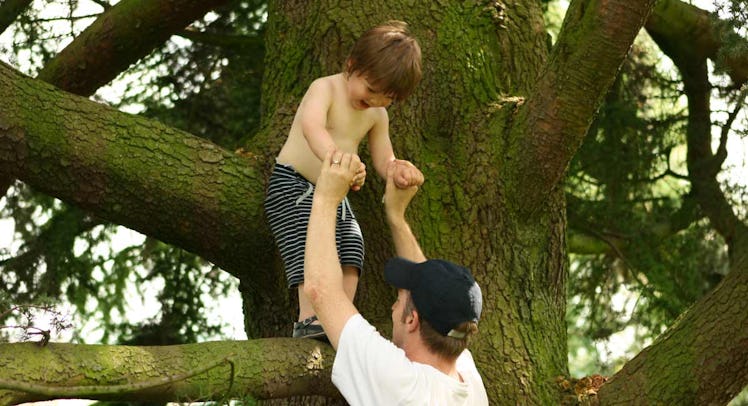Want to Teach a Kid to Climb Trees? Show Them How to Do It.
A professional arborist breaks down the best way to start scaling branches.

Climbing trees and scrambling branches, aside from being a blast, can also be great for your child’s development. Opportunities for tree-climbing are everywhere and the scramble upward is, for many children, a first real taste of natural adventure. Many fathers take the “encouragement from the ground” approach to keeping kids safe (“Don’t put your weight on that!”), but the better approach, as in all things, is to model good behavior. Fathers should show their daughters and sons how to climb trees. In order to do this, they need to know how and, no, most adults really don’t.
James Reed does. An instructor from Tree Monkey Project, Reed is a Certified Arborist and professional tree climber, who for the last 14 years has traveled throughout the U.S. doing hazardous tree work after hurricanes and other natural disasters. He’s also been a recreational tree climbing enthusiast, and a member of Tree Climbers International and Global Organization of Tree Climbers. Before scaling any tree, he recommends taking the time to carefully inspect it, checking if it’s going to be easily-accessible from close to the ground.
“The first thing that we start with is low and slow,” he says. “Make sure that the tree is safe by making sure that it has low branches, low access points, that can easily be managed. Start with small trees.”
The reason for sticking to low branches isn’t just an issue of convenience or a way to mitigate the risk of a fall. The higher up in the tree you go, the younger the branches are, and they’ll tend to be weaker and break more easily.
Once you’ve climbed up in a low access point, testing out branches before moving on becomes critical. “Never grab onto anything that’s dead,” Reed warns. “Hold on with a firm grip, that’s obvious. But make sure to test the weight before you completely stand on it. Put a little bit of weight on it. See if it starts to move. If it bobs when you put your foot down, consider trying another branch.”
And if the branch seems sturdy? Don’t trust it.
“Don’t go further than halfway. Staying close to the trunk is going to give you the most strength out of the branch. The farther you go from the trunk the more likely the branches are going to break.”
Reed stresses that these are universal safety rules, and the list of trees that make the cut is endless, even independent of species. “Anything with low hanging branches and low trunks that split up. A lot of ornamental trees are easiest for kids to climb because they’re small, they’re designed to be small genetically. Hard woods are sturdier as far as the branches go. Soft woods tend to have thinner branches that are more brittle, and they take less weight.”
As long as safety precautions are followed, Reed strongly advocates for the educational benefits of tree-climbing. “Tree-climbing is 3-D,” he says. “I think by not letting kids climb trees, we’re keeping them from understanding their 3-D balance in the world.” Furthermore, there’s a strong ecological component along with the spatial one. “There’s an exchange that you’re doing by climbing on a living organism as opposed to climbing on rock or on a playground. That’s a total natural connection.”
This article was originally published on